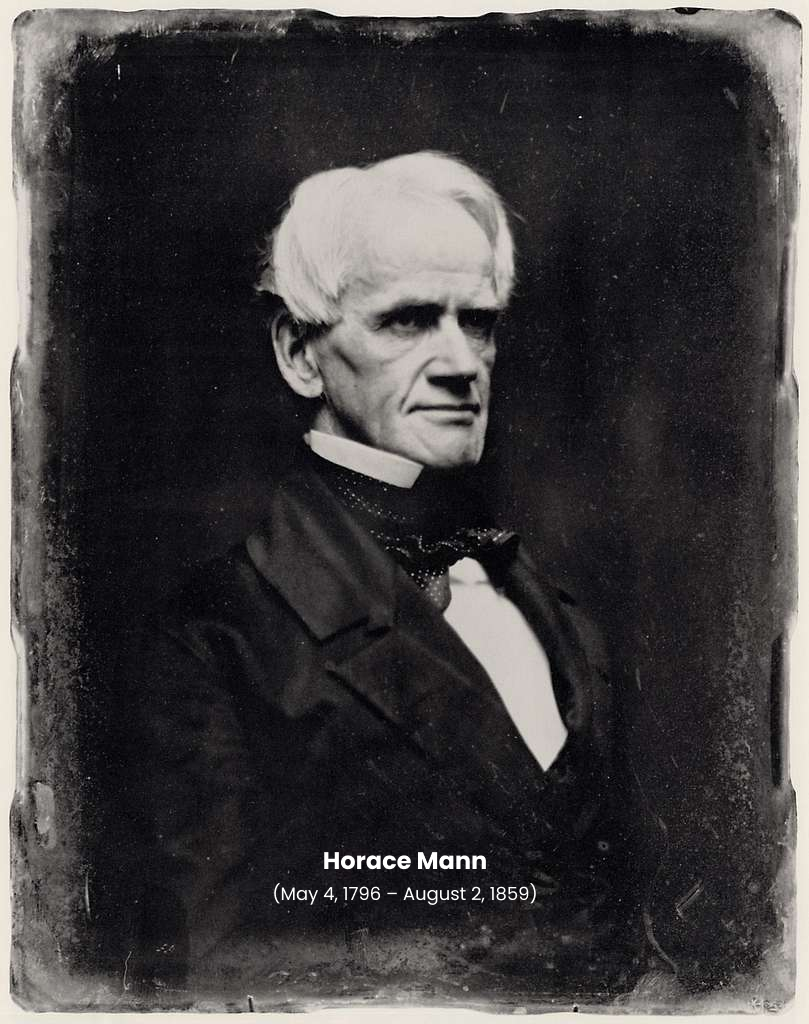If school isn’t for you, it may be easy to think of it as some eternal blight: the understated Fifth Horseman that puts pestilence and war to shame. Ok, that’s probably a stretch.
In all seriousness, have you ever thought about how we got our modern-day concept of“school?” Who started it? Where did it begin? What did the first “students” learn, and why didwe as humans need to invent a brand-new institution for them to learn it?
In this article, let’s zoom out beyond the educational content that we take for granted today. Let’s learn where “school” itself came from.
The Problem With Asking Who Created School
In the United States, the inventor of school as we know it is widely considered to be HoraceMann. In the mid-nineteenth century, the Whig reformer pioneered a system of “common school” education in his native Massachusetts, the success of which then encouraged other states to follow his blueprint. In a country marked by sharp regional and religious differences, Mann argued that public education would establish universal standards for academic as well as moral instruction.

But that’s… just the United States. While we’ll discuss Mann’s innovations later, we should acknowledge that he didn’t invent education itself. Though public schooling is, indeed, a more modern addition to our social welfare, it didn’t mark the first time teachers and students came together to transmit information. Before we arrive at “school,” let’s first locate from whom, where, and when we get the dynamic of education itself, regardless of whether it was called “school” at the time.
Tracing a Broader History of Learning
In other words, asking who created school and why is only part of the puzzle. The history of education developed slowly and with piecemeal inclusion of different members of society; as a spoiler, “schools” have been around for thousands of years and, as we’ve established, universal public schools only began barely more than a century ago.
We can’t even celebrate true universality today. In the United States, bastion of the world’s top colleges, barely more than half of American citizens had earned a college degree in 2022. In the United Kingdom, it’s barely one quarter. Literacy rates, perhaps the most important metric of education worldwide, have skyrocketed in the past two hundred years, but strong regional and gender inequalities persist. Clearly, we still have some work to do.
But that’s a different discussion. The point is that we have to recognize the legitimacy of “schools” even when they were reserved for certain members of society. Only then can we understand accurately how the institution evolved over time.
In a Nutshell: When Was School Invented
The question of who invented school has multiple answers. Every great ancient society, from Egypt to Mesopotamia to China to Greece, created some form of education whereby trained officials, usually priests or scribes, transmitted their knowledge to successive generations of the powerful and privileged.
But so does the question of when school was invented. Roughly speaking, civilizations of antiquity developed their first educational systems in the first and second millennia BCE. The Xia Dynasty, the first of Ancient China, established the earliest “schools” as we understand them.
However, we can thank the Greeks for the word “skholē” itself, which refers both to “leisure” and “a place for lectures.”
Why Was School Invented: Religious Reasons
Ancient educational systems focused heavily on religious education. Early formal schooling was created largely to train priests, whose temples in places like Mesopotamia contained libraries and were thus the nuclei of intellectual life. Subjects like reading and writing were taught alongside, and also in service of, religious pursuits like astrology.
It shouldn’t be surprising, therefore, that schooling remained within the purview of the clergy well into the medieval period. In Christian Europe, aspiring priests and monks sought literacy specifically as a stepping stone to learning scripture and Latin – not just for the sake of memorization but also so as to reinforce “Christian” moral principles.
Why Was School Invented: Secular Reasons
That said, the upper crust of ancient societies didn’t pursue education just so they could preach. In Egypt, priests still taught secular subjects like mathematics and science. In Greece, wealthy boys studied the philosophy and rhetoric that, at that time, were essential to wielding political and social influence.
Before the invention of the printing press, one of the most important functions of learning to write was so that future teachers and government officials could serve as “scribes” who could copy important documents. And for those who sought to become traders or effective businessmen, learning formal arithmetic was a critical asset.
Who Created the First Universities?
The concept of the university developed naturally as an extension of lower-level schooling during the medieval period, invented to instill clergymen and scientists with greater levels of expertise.
The first universities developed throughout Western Europe, North Africa, and the Middle East, from Ez-Zitouna University in Tunisia (founded ~700 CE) to the University of al-Qarawiyyin in Morocco (857-859 CE) to Salerno, Italy’s medical school (9th century CE) to England’s University of Oxford (~1096 CE).
Early universities taught scholars subjects like canon law, theology, and medicine, continuing earlier traditions of balancing religious and secular knowledge. By the end of the medieval period, they had been widely established in cities across Europe and the Arab world, where they were known as madrasas.
Why Were Universities Invented in the First Place?
As mentioned, higher education systems picked up where ordinary schools left off. Believe it or not, scholars in antiquity and medieval times couldn’t just Google, “Please write my essay for me on the principles of divine law,” nor could any custom writing service compile resources for them with a few clicks.
Physical information was much more limited before the printing press – books were literally chained to their desks – and places that could house libraries became hallowed intellectual ground. There’s a reason why the word itself derives from the Latin phrase “universitas magistrorum et scholarium,” or “community of masters and scholars.”
What Did the First Universities Teach?
Let’s take Cambridge University, founded in 1209 by former Oxford scholars, as a case study. In the medieval period, Cambridge students prioritized foundational subjects like logic and rhetoric, harkening back to Ancient Greece, but also learned mathematics, music, and astronomy. At the highest level, they advanced to subjects like divinity, canon (church) law, and civil (government) law.
What did classes actually look like? Believe it or not, there was no such thing as an admission essay writing service back then. “Normal” classes consisted of analyzing and discussing texts, while examinations consisted of oral arguments between students, who posited theses, and their masters.
Fast Forward: “School” As We Know it Today
Now, let’s jump forward to education as we now understand it. As we continue, let’s think about why modernizing reformers felt the need to change the traditional systems we’ve been discussing.
Why was school created when temples and monasteries already existed? When was school created for predominantly secular reasons? Who invented school system curricula that catered to all members of society? (That last one might give away the answer.)
Put simply, who invented school and why comes down to one word: equality. For this section, we’re going to focus on the innovations of American education and the ideas of the “common school” movement’s leading pioneer.
Who Made School What It is Today?
As we’ve established, the person who invented school, or at least is most responsible for its modern scope, was Whig politician Horace Mann. In his own words, Mann argued that “[p]arents, children, the State itself…have an interest, precious and unspeakable, in the prosperity of the schools.” Separating his thought from the European tradition, in which “men are divided into classes,” Mann believed in an alternative “Massachusetts theory” which touted which promoted an “equal chance for earning” regardless of wealth or sectional differences.
Furthermore, Mann’s insistence that the state had an obligation to support education lay the groundwork for modern public schools, which are funded by taxpayers and thus non- discriminatory.
When Was the First School Created in Modern Times?
While Massachusetts’s public school system had its roots in the seventeenth century, Mann’s efforts to reinvigorate state-funded education resulted in the 1837 establishment of the state’s board of education, on which Mann served as its first secretary.
Against resistance from the clergy, who protested the idea of nonsectarian education, and local authorities who ceded influence to the new board, Mann plowed ahead with his vision of a centralized authority which collected funding from, and distributed tax dollars to, schools across Massachusetts. The “Common School Movement,” as it was known, was then carried forward by like-minded reformers who replicated Mann’s state system nationwide.
How Public Schools Were Different
Mann’s vision for public schooling did carry a heavy moral component; exalting the state’s role in ensuring equal education, in pursuit of an informed republic, Mann publicly contrasted the prospect of an uneducated public – a “mad-house” – with his belief that Common Schools would become “the most effective and benignant of all forces of civilization.”
However, Mann-style schools were also avowedly, significantly, non-sectarian. Neither religious nor class differences would disrupt, with their exclusionary histories, the reformer’s idealized republic of the enlightened. Instead of sending rich students to universities and poor students toward class-static vocations, American public schools sought a universalism that would shed centuries of Old World societal disunity.
Who Else Was Involved?
While Horace Mann is known as the Father of American Education, he was not the only reformer interested in standardizing public schools. In the same period, the prospect of common education, along with temperance, women’s suffrage, and abolition of slavery, became a key issue for those who wanted to make America more modern, just, and united.
Along with Mann worked Catherine Beecher, a New York feminist and sister of Harriet Beecher Stowe, who wrote the seminal anti-slavery novel Uncle Tom’s Cabin. So did Henry Barnard, a Connecticut lawyer, teacher, and superintendent who reorganized Northeastern schools and eventually served as U.S. Commissioner of Education. Finally, we’ll mention the McGuffey brothers, William and Alexander, who created the nineteenth century’s most widely used textbooks (McGuffey Readers) and thus advanced mass literacy nationwide.
The Evolution of Education
If you had never thought about where your modern curricula came from, now you know more about who created school and why. From its ancient origins to its medieval developments to its modern zeitgeist, formal education has a fascinating history that spans time, space, and ideas about who belongs in the classroom.
The fact that no one civilization can claim to have invented such a pursuit of knowledge signifies, we think, that learning is intrinsic to the human spirit. For how much we may complain about incompetent or harsh teachers, the fact that they’ve been around for so long is, in the end, something to celebrate.
Works Cited
1. Antioch College. “Common School Journal – Mann.” Antioch College, 16 Jan. 2020, https://antiochcollege.edu/2020/01/16/common-school-journal-mann/.
2. Anderson, Sam. “The Evolution of the College Library.” The Atlantic, 10 Dec. 2013, https://www.theatlantic.com/education/archive/2013/12/the-evolution-of-the-college-library/282023/.
3. University of Cambridge. “The Medieval University.” University of Cambridge, https://www.cam.ac.uk/about-the-university/history/the-medieval-university.
4. “Education in the Earliest Civilizations.” Encyclopaedia Britannica, https://www.britannica.com/topic/education/Education-in-the-earliest-civilizations.
5. “Horace Mann.” Encyclopaedia Britannica, https://www.britannica.com/biography/Horace-Mann.
6. “University.” Encyclopaedia Britannica, https://www.britannica.com/topic/university.
7. Nietzel, Michael T. “Percentage of U.S. Adults with College Degrees Edges Higher, Finds Lumina Report.” Forbes, 1 Feb. 2024, https://www.forbes.com/sites/michaeltnietzel/2024/02/01/percentage-of-us-adults-with-college-degrees-edges-higher-finds-lumina-report/.
8. Horizon Educational. “Who Invented School? A History of Classroom Education.” Horizon Educational, https://www.horizoneducational.com/who-invented-school-a-history-of-classroom-education/t1504?currency=usd#:~:text=The%20first%20schools%20were%20created,children%20of%20ordinary%20citizens%20studied.
9. OECD. “Country Profile: United Kingdom.” GPS Education OECD, https://gpseducation.oecd.org/CountryProfile?primaryCountry=GBR&treshold=10&topic=EO.
10. “School.” Etymonline, https://www.etymonline.com/word/school.
11. “University.” Etymonline, https://www.etymonline.com/word/university.
12. U.S. Embassy in Germany. “Horace Mann: U.S. Educator.” usa.usembassy.de, https://usa.usembassy.de/etexts/democrac/16.htm.
13. PBS. “Horace Mann: Only a Teacher.” PBS, https://www.pbs.org/onlyateacher/horace.html#:~:text=Horace%20Mann%2C%20often%20called%20the,to%20enact%20major%20educational%20reform.
14. World Economic Forum. “How the Global Literacy Rate Has Changed.” World Economic Forum, 16 Sept. 2022, https://www.weforum.org/agenda/2022/09/reading-writing-global-literacy-rate-changed/.



